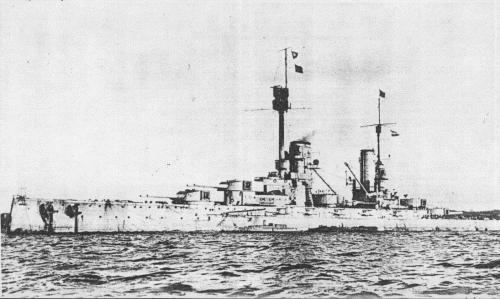
NAVYPEDIA
 Support the project with paypal
Support the project with paypal
Photo

Grosser Kurfürst 1914
Ships
| Name | No | Yard No | Builder | Laid down | Launched | Comp | Fate |
|---|---|---|---|---|---|---|---|
| König | 33 | Wilhelmshaven KW | 10/1911 | 1.3.1913 | 9.8.1914 | interned 12.1918, scuttled 21.6.1919 | |
| Grosser Kurfürst | 4 | Vulcan, Hamburg | 10/1911 | 5.5.1913 | 30.7.1914 | interned 11.1918, scuttled 21.6.1919 | |
| Markgraf | 186 | Weser, Bremen | 11/1911 | 4.6.1913 | 1.10.1914 | interned 11.1918, scuttled 21.6.1919 | |
| Kronprinz, 6.1918- Kronprinz Wilhelm | 182 | Germaniawerft, Kiel | 5/1912 | 21.2.1914 | 8.11.1914 | interned 11.1918, scuttled 21.6.1919 |
Technical data
| Displacement normal, t | 25796 |
|---|---|
| Displacement full, t | 28600 |
| Length, m | 175.4 oa 174.7 wl |
| Breadth, m | 29.5 |
| Draught, m | 9.00 mean 9.19 deep load |
| No of shafts | 3 |
| Machinery | König, Kronprinz: 3 Parsons steam turbines, 15 Marine boilers Grosser Kurfürst: 3 AEG-Vulcan steam turbines, 15 Marine boilers Markgraf: 3 Bergmann steam turbines, 15 Marine boilers |
| Power, h. p. | 31000 |
| Max speed, kts | 21 |
| Fuel, t | coal 3000 + oil 600 |
| Endurance, nm(kts) | 8000(12) |
| Armour, mm | belt: 350 - 80, bulkheads: 300 - 130, deck: 100 - 60, main turrets: 300 - 80, barbettes: 300 - 80, casemates: 170, CT: 300 - 200 |
| Armament | 5 x 2 - 305/47 SK L/50 C/08, 14 x 1 - 149/42 SK L/45 C/09, 6 x 1 - 88/45 SK L/45 C/13, 4 x 1 - 88/45 FlaK L/45 C/13, 5 - 500 TT (1 bow, 4 beam) |
| Complement | 1136 |
Standard scale images

König 1918
Graphics
Project history
These ships were essentially improved Kaisers with a much better turret distribution. The first three were built under the 1911-12 programme and Kronprinz under that of 1912-13. The run of the forecastle deck and freeboard were similar but the funnels were not so far apart as in Kaiser. GM was 2.59m and fighting draughts apparently varied from 8.85m to 9.05m. The turrets were all on the centreline with superfiring pairs fore and aft and the fifth between the funnels at the same height as the after super-firing one. The mountings were Drh LC/11, similar to C/09 and with 13.5° elevation, increased to 16°. Magazines were all below shell rooms. The 15cm battery was on the upper deck. TT were arranged as in Kaiser. There were 3 oil-fired and 12 coal-fired boilers, with the oil-fired in the 3 foremost boiler rooms, 6 coal-fired in the next 3 and another 6 in the 3 after boiler rooms. The 3 sets of turbines were in 6 engine rooms, and boiler pressure remained at 16.5 kgf/cm2. Deep water mile at Neukrug could not be used and figures were 41,400shp-46,200shp = 21.0kts-21.3kts. In service they were faster than the Kaiser class, and Grosser Kurfürst was apparently considered the fastest and was said to have touched 24kts, though at Jutland she was outpaced by König.
Ship protection
The side armour was much improved, the belt between end barbettes being 350mm from the main deck 1.8-1.8m above lwl to 350mm below lwl, and tapering to 180mm at 1.7m below lwl, with 200mm between main and upper decks. Forward there was 200-80mm and aft 200-125mm. Barbettes were 300-220mm reduced to 140mm behind the battery and upper belt armour and to 80mm behind the main belt, while the turrets had 300mm faces, 250mm sides, 290mm rears and 110-80mm roofs. Casemates had 170mm sides and were closed by 80mm bulkheads. The armour deck was 30mm amidships, 60mm forward and 1120-60mm aft while between end barbettes the upper deck was 30mm outside the battery and 20mm as the battery floor and the forecastle deck 30mm over the latter. The torpedo bulkhead was 50mm, and was continued as a 30mm splinter bulkhead to the upper deck. Fwd CT had 300mm sides and 150mm roof, aft CT had 200mm sides and 50mm roof.
Modernizations
1916-1917, all: - 10 x 1 - 88/45 (only 2 AA guns remained).
Naval service
Grosser Kurfürst and Kronprinz were both torpedoed by British submarine J1 on 5 November 1916, respectively right aft (jamming the port rudder) and under the bridge, but both maintained 17kts-19kts. In the Gulf of Riga operations Grosser Kurfürst was mined on 12 October 1917 and Markgraf on the 29th but the torpedo bulkhead limited flooding in both to 260-280 tons. At Jutland König was hit by 1 381mm and 9 343mm shells, Grosser Kurfürst by 5 381mm and 3 343mm, and Markgraf by 3 381mm, 1 343mm and 1 305mm. The worst damage to König was from a 343mm CPC on the 180mm extreme lower edge of the belt which burst about 2m inboard sending many fragments through 2m of coal and the 50mm torpedo bulkhead into a 15cm ammunition room. Sea water flooding in limited the tire to 15 cartridges, but most of the 1630 tons reported after the battle was from this hit. In Grosser Kurfürst a 343mm APC hit the 150mm armour forward near the waterline and burst making a hole 1.3x0.9m. Almost the whole fore part of the ship except the torpedo flats and trimming tanks flooded up to the main deck increasing the draught forward by 1.5m. Grosser Kurfürst was raised at Scapa for scrap in 1936, but salvage rights on the others were not granted until 1962.
 HOME
HOME FIGHTING SHIPS OF THE WORLD
FIGHTING SHIPS OF THE WORLD GERMANY
GERMANY CAPITAL SHIPS
CAPITAL SHIPS KÖNIG battleships (1914)
KÖNIG battleships (1914)
